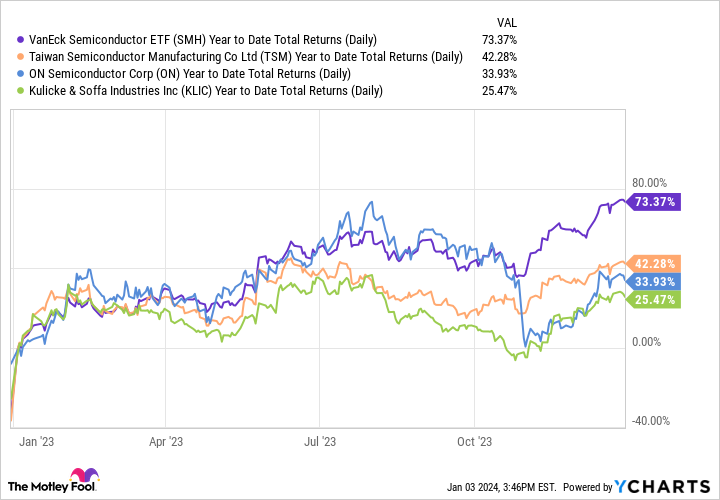To say that 2023 was a good year for semiconductor stocks is an understatement. The sector, at least as defined by the VanEck Semiconductor ETF (NASDAQ: SMH), rocketed 73.4% in 2023! So if you had shied away from this volatile yet important part of the market, you likely missed out on some of the biggest gains of the year.
The artificial intelligence (AI) revolution no doubt played a big part, causing some of the largest names like Nvidia and Advanced Micro Devices to rise 239% and 128%, respectively.
But there are other, really important chip companies with strong business models and important long-term growth trends that lagged the sector. On that note, the following three stocks still look like bargain-priced options in the red-hot sector today.
SMH Year to Date Total Returns (Daily) data by YCharts.
Taiwan Semiconductor Manufacturing
The world’s largest chip foundry Taiwan Semiconductor Manufacturing (NYSE: TSM) was up “only” 42.3% in 2023, including its 1.9% dividend. But that left the stock only trading around 18 times trailing earnings and under 16 times this year’s earnings estimates.
That’s certainly a more-than-reasonable price to pay for the world’s largest foundry that makes basically all of the world’s most important chips, from Nvidia’s H100 accelerators to AMD’s Instinct MI300 to Apple‘s M-series laptop and A-series mobile processors.
2023 was a down year for many key semiconductor markets, including both PCs and smartphones, which are still the largest chip end markets today. Investors became disappointed in TSMC’s results mid-year after second-quarter earnings when management revealed that AI chips made by Nvidia only made up a mid-single-digit percentage of the overall industry. Given how huge Nvidia’s growth was last year, that appeared to surprise some investors, who may have been hoping for a bigger AI surge for TSMC.
But TSMC stock clawed its way back toward the end of the year when growth surprised to the upside. In its Q2 earnings call with analysts, TSMC management revised down prior guidance for the year, anticipating revenue would fall around 10% for the year.
However, things turned out much better than anticipated, as AI demand remained very strong while other key markets started to turn around. TSMC releases its monthly revenue, and through November, its 11-month revenue was only 4.1% below that of 2022 — much better than the anticipated 10% decline.
Eventually, all of those laptops and smartphones bought during the 2020 to 2021 pandemic period will have to be replaced, likely by higher-end chips for AI PCs and other advanced machines. Furthermore, AMD’s CEO Lisa Su just increased her outlook for the AI chip market to $400 billion by 2027, up from her June prediction of just $150 billion.
While TSMC said it expects AI chips to grow from a mid-single-digit percentage of its revenue to a mid-teens percentage over time, that is probably conservative. With a larger AI market growing very fast as other markets are turning around, look for TSMC to post strong growth in the year ahead.
On Semiconductor
The electric vehicle (EV) market is projected for long-term growth, especially as technology improves and costs come down. But 2023 saw a slowdown in the market, causing many EV-related stocks to plunge in Q2 and Q3, like silicon carbide leader On Semiconductor (NASDAQ: ON).
This year, the supply chain shortages that plagued the industry in 2021 and 2022 were alleviated, leading to ample supply. Meanwhile, higher interest rates dampened demand for EVs, which tend to be a bit pricier than the typical internal combustion engine (ICE). A late summer report showed that EV inventories were piling up at dealerships in the U.S., with some major automakers saying they would slow their battery and EV manufacturing plans.
Those fears appeared justified when On reported Q3 earnings, during which it guided for a soft Q4. On is currently a leader in silicon carbide power chips, a difficult-to-manufacture semiconductor alloy that is especially useful in high-power applications, like electric vehicles and infrastructure. The company blamed the slowdown on a very large European customer that had paused some orders, which isn’t surprising given the news about slower adoption of certain EV models.
But fears that EVs have exhausted early adopters may be misplaced. After all, despite the slowdown, EVs are still growing faster than ICE cars in the U.S., Europe, and China — just not as fast as some more bullish observers may have anticipated. And as interest rates moderate and charging infrastructure improves, customer adoption should eventually be there.
So near-term fears may have opened up an opportunity for longer-term investors in On. After all, the stock only trades at less than 16 times earnings. Moreover, the company is set to improve margins as it brings its new 300mm East Fishkill plant up to speed, so there is also a self-help, margin-improvement story here as well.

Kulicke and Soffa
The AI revolution has put a big focus on whichever chipmaker can produce the fastest and most power-efficient chip at the most advanced node. But investors shouldn’t ignore chip-packaging companies either, such as industry leader Kulicke and Soffa (NASDAQ: KLIC). These types of companies are somewhat less sexy and use more commoditized machines that connect chips together on a motherboard or even to each other, usually through copper wires or small copper “bumps.”
But as chips become more complex, a greater focus will come on packaging. This is especially true as power and electricity concerns come to the fore, since more powerful chips require more electricity and generate more heat. AI chipmakers are even beginning to construct chips made of “chiplets,” which are optimized pieces of silicon stitched together, with new, advanced packaging technologies, into “superchips.” For instance, AMD’s MI300 is made out of 13 different chiplets.
Kulicke and Soffa has a dominant market position in “legacy” ball bonder packaging equipment, demand for which fluctuates with cycles. But it has smaller revenue segments in newer up-and-coming technologies, such as thermocompression bonding for chiplets, EV battery packaging, and microLEDs — a new kind of advanced screen that is currently in high-end electronics but could one day eventually spread to smartphones.
Not unlike TSMC, Kulicke’s mature business in ball bonding is in a downcycle, causing a massive decline in earnings over the past year, from $7.09 in 2022 to just $0.99 in 2023. But if those are the two extremes, one could argue Kulicke’s average earnings power is around $4 per share. With the stock at just $51.50 with nearly $13.40 in cash on the balance sheet with no debt, the company’s enterprise value (around $38 per share) to average earnings ($4) would be under 10.
That’s a cheap stock no matter which way you cut it, making Kulicke and Soffa an under-the radar pick in 2024.
Should you invest $1,000 in Taiwan Semiconductor Manufacturing right now?
Before you buy stock in Taiwan Semiconductor Manufacturing, consider this:
The Motley Fool Stock Advisor analyst team just identified what they believe are the 10 best stocks for investors to buy now… and Taiwan Semiconductor Manufacturing wasn’t one of them. The 10 stocks that made the cut could produce monster returns in the coming years.
Stock Advisor provides investors with an easy-to-follow blueprint for success, including guidance on building a portfolio, regular updates from analysts, and two new stock picks each month. The Stock Advisor service has more than tripled the return of S&P 500 since 2002*.
See the 10 stocks
*Stock Advisor returns as of December 18, 2023
Billy Duberstein has positions in Apple, Kulicke And Soffa Industries, and Taiwan Semiconductor Manufacturing. His clients may own shares of the companies mentioned. The Motley Fool has positions in and recommends Advanced Micro Devices, Apple, Nvidia, and Taiwan Semiconductor Manufacturing. The Motley Fool recommends ON Semiconductor. The Motley Fool has a disclosure policy.
The Semiconductor Sector Rocketed 73% Higher in 2023, But These 3 Players Still Look Like Bargains was originally published by The Motley Fool
Credit: Source link




